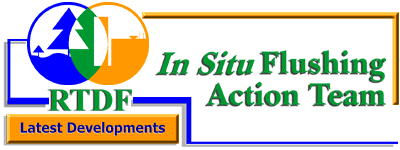
|
|||||||

|
|||||||
|
|
|
What Is the In Situ Flushing Action Team?The In Situ Flushing Action Team, established in 1997, is one of seven Action Teams under the Remediation Technologies Development Forum (RTDF). The U.S. Environmental Protection Agency (EPA) created the RTDF in 1992 to foster collaboration between the public and private sectors in developing innovative solutions to mutual hazardous waste problems. The In Situ Flushing Action Team includes representatives from industry, government, and academia who share an interest in facilitating the development, evaluation, and potential implementation of chemically enhanced contaminant extraction methodologies for subsurface remediation.
What Are In Situ Flushing Technologies?In situ flushing technologies reduce ground-water contaminant concentrations by injecting an aqueous solution containing chemical adjuvants (e.g., surfactants and cosolvents) into highly contaminated source zones. Subsurface contaminants are solubilized and/or mobilized by the injected flushing solution and then extracted via downgradient extraction wells for above-ground treatment. Advantages of in situ flushing include:
What Is the Action Team's Mission?The Action Team’s mission is to facilitate the development, evaluation, and implementation of in situ flushing technologies for source remediation.
What Action Items Has the Team Identified?The action items identified by this RTDF group are tied together under one “umbrella” project involving the conceptual design of a large-scale in situ flushing study. Action items are to:
The Action Team is in the process of forming work groups to investigate the above-listed action areas. Other action items identified by the In Situ Action Team include:
Would You Like More Information?For more information about the In Situ Flushing Action
Team, please contact:
|